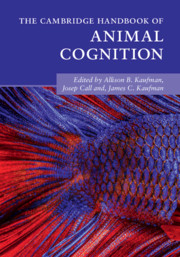Book contents
- The Cambridge Handbook of Animal Cognition
- The Cambridge Handbook of Animal Cognition
- Copyright page
- Dedication
- Contents
- Figures, Tables, and Boxes
- Contributors
- Acknowledgments
- Introduction
- Part I Communication and Language
- Part II Memory and Recall
- Part III Social Cognition
- Part IV Social Learning and Teaching
- Part V Numerical and Quantitative Abilities
- 24 Numerical and Quantitative Abilities Overview
- 25 Numerical Competence in Fish
- 26 Spatial–Numerical Association in Nonhuman Animals
- 27 Perceptual Categorization in Pigeons
- Part VI Innovation and Problem-Solving
- Index
- References
24 - Numerical and Quantitative Abilities Overview
from Part V - Numerical and Quantitative Abilities
Published online by Cambridge University Press: 01 July 2021
- The Cambridge Handbook of Animal Cognition
- The Cambridge Handbook of Animal Cognition
- Copyright page
- Dedication
- Contents
- Figures, Tables, and Boxes
- Contributors
- Acknowledgments
- Introduction
- Part I Communication and Language
- Part II Memory and Recall
- Part III Social Cognition
- Part IV Social Learning and Teaching
- Part V Numerical and Quantitative Abilities
- 24 Numerical and Quantitative Abilities Overview
- 25 Numerical Competence in Fish
- 26 Spatial–Numerical Association in Nonhuman Animals
- 27 Perceptual Categorization in Pigeons
- Part VI Innovation and Problem-Solving
- Index
- References
Summary
The study of numerical capacities in animals has a long and colorful history, and has enjoyed a resurgence of intriguing experiments in recent years, exploring a variety of species outside the use of more typical laboratory species, including nonhuman primates, in the past two decades.A wealth of new studies has been forthcoming, including a significant number of well-controlled experiments with fish, and have examined the contribution of group size, movement, species, and sex of fish, surface area of aggregated conspecifics, number vs. continuous quantity, and the development of quantity-discrimination skills.Most such skills appear to be within the capacity of certain fish species, and these studies have also been expanded to include other amphibians, such as salamanders, frogs, and toads.Additional studies have been extended to canid populations not previously examined for numerical skills, including feral dogs, coyotes, and wolves.While much of the last thirty years of experiments with more complex numerical skills in animals were conducted with chimpanzees, more recent studies with monkeys and continued comparisons with chimpanzees have established a host of demonstrated skills in the archival literature.The area of quantity discriminations, numerosity, and numerical skills remains an exciting and vibrant area for future experimental work in comparative cognition.
- Type
- Chapter
- Information
- The Cambridge Handbook of Animal Cognition , pp. 561 - 579Publisher: Cambridge University PressPrint publication year: 2021
References
- 1
- Cited by



